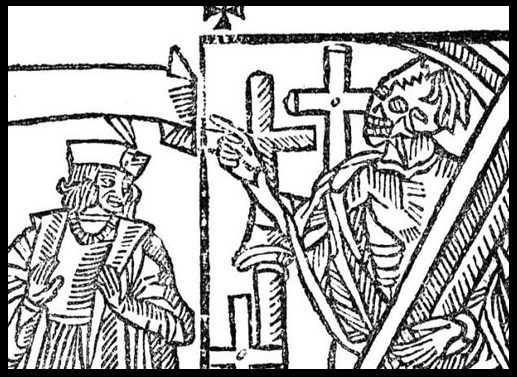
Everybody by Branden Jacobs-Jenkins
directed by KT Turner
dramaturgy by Ariana Burns
(Section of frontispiece from edition of Everyman published by John Skot c. 1530.)
The sixteenth century morality plays were staged at a time when mortality outpaced the birth rate due largely to war, famine, and disease. Clifford Davidson wrote that cities maintained population size with an influx of immigrants (Davidson). A person living during this period was keenly aware that death could come without warning.
Morality plays, which were first presented by the church then the guilds with church oversight, offered meaning in God’s world. By staging them outside of the church and in the vernacular, it reinforced Christ’s presence in the everyday world. That God was not only found in hallowed halls. The writers told stories of Jesus Christ and his time on earth, his care for humankind and the sacrifice to redeem humankind (Tydemann, p 10; Wertz, p 541; Kaula, p 9). Using the morality plays , the church was able to edify and prepare congregations for the day of reckoning. Dorothy Wertz wrote that the presentations could inspire audiences to face their own accounting after seeing a stage character repent and be redeemed:
The audience, facing together the figure that all of them must at some future time meet separately, perhaps gained a measure of assurance in the face of their own deaths, an assurance that vastly increased when they later saw Manssoul saved (Wertz, p 446.)
The Christian lessons in these plays were shown to the audiences allegorically, using simpler ideas to express complex ones. Braswell described allegory as a sort of “continuing metaphor” as a series of related images or acts (p 125-126). This overlay of ideas would at times distance the audience from the action of the play causing them to reflect on what was happening.
Along with impression left on the audience, the allegorical qualities also served to bring the audience out of the story at times. This might be akin to Brecht’s distancing effect. Everyman would describe what had transpired and what it meant for their future. This in turn caused the audience to reflect on their own lives (Garner, p 283).
Morality plays were noted for their transformative power and one of the reasons cited for that by Meg Twycross was their immediacy. It made it a personal memory which stayed with the attendees after the event. This same immediacy was something Garner argued would be lost in the allegorical distancing (Garner, p 283; Twycross, “Theatre,” p 340; Wright, p 257). If the morality plays were moving between immediacy and distancing, it would’ve have created an interesting frisson for the audience.
It was this staying power that Davidson found that would give a morality play its strength as he eloquently described here:
… the power of such a play as Everyman, even if read rather than staged, would presumably have been more deeply felt than today and would have left a more powerful lasting impression. The intended visual effect, whether on stage or in the imaginations of readers, was to create a kind of memory theater to which the mind would return again and again as a way of being reminded in symbolic terms of human mortality and the consequences of one’s actions in this life. Clifford Davidson
Attending morality plays, created memories of sensations experienced witnessing the story which stayed with the audience (Wright, p 242). It made the play and the allegories within present with the audience after the morality play had concluded.
Braswell, Laurel. “The Visionary Voyage in Science Fiction and Medieval Allegory,” Mosaic: An Interdisciplinary Critical Journal, Winter 1981, Vol. 14, No. 1, pp. 125-142. University of Manitoba. Stable URL: https://www.jstor.org/stable/24780359. Last Accessed: Jan 9, 2021.
Davidson, Clifford. “Introduction.” Everyman and Its Dutch Original, Elckerlijc. Eds: Davidson, Clifford Davidson; Martin W. Walsh; Ton J. Broos. 2007. d.lib.rochester.edu/ teams/ text/ davidson-everyman-introduction. Last accessed: Jan 9, 2021.
Garner, Jr., Stanton B. “Theatricality in ‘Mankind’ and ‘Everyman’” Studies in Philology, Summer, Vol. 84, No. 3 (Summer, 1987), pp. 272-285 University of North Carolina Press Stable URL: https://www.jstor.org/stable/4174272. Last accessed: Dec 1, 2020.
Kaula, David. “Time and the Timeless in Everyman and Dr. Faustus” College English, Oct., 1960, Vol. 22, No. 1 (Oct., 1960), pp. 9-14. Published by: National Council of Teachers of English. https://www.jstor.org/stable/373857. Last Accessed Dec 22, 2020.
Twycross, Meg. “The Theatre.” The Blackwell Companion to the Bible and Culture. Edited by Sawyer, John F. A. Blackwell Publishing Ltd. 2006.
Tydemann, W. English Medieval Theatre. 1400-1500. Routledge & Kegan Paul. (London) 1986.
Wertz, Dorothy. “Conflict Resolution in the Medieval Morality Plays” The Journal of Conflict Resolution, Dec., 1969, Vol. 13, No. 4 (Dec., 1969), pp.438-453. Sage Publications, Inc. https://www.jstor.org/stable/173563. Last Accessed: Jan 7, 2021.
Wright, Clare. Sound, Body and Space: Audience Experience in Late Medieval English Drama. PhD thesis, University of Nottingham. 2011. Access from the University of Nottingham repository: http://eprints.nottingham.ac.uk/13108/1/555408.pdf. Last accessed: Jan 1, 2021.